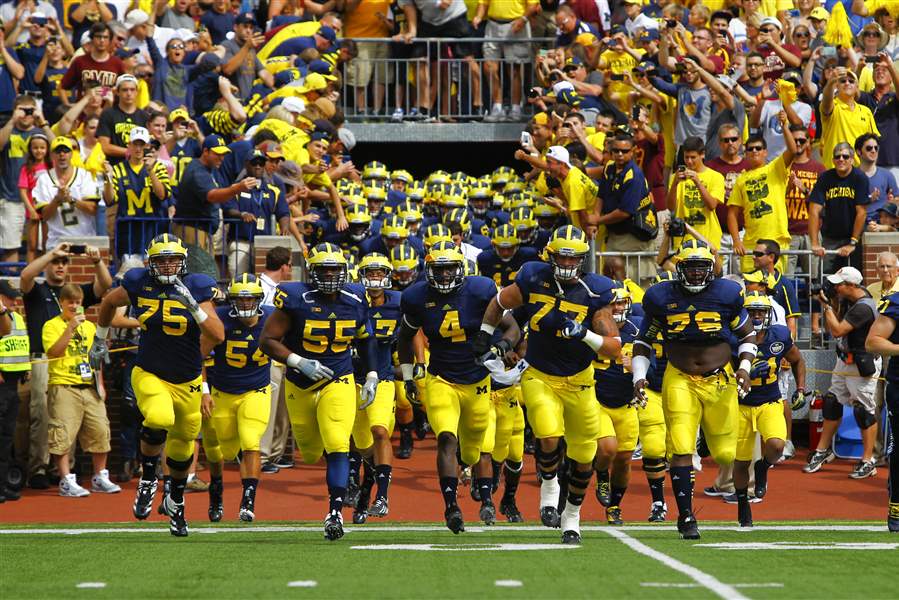
Wolverines hit with rash of ACL injuries
Doctor says incidents just result of bad luck
4/5/2014
The Wolverines conclude their spring practices at 2 p.m. today with the annual spring game at Michigan Stadium, which for the second year will be a practice and an intrasquad scrimmage.
BLADE PHOTO
ANN ARBOR — Brady Hoke attributes his team’s spate of anterior cruciate ligament tears only to bad luck, and a local orthopedic surgeon won’t disagree with the fourth-year Michigan football coach.
The Wolverines conclude their spring practices at 2 p.m. today with the annual spring game at Michigan Stadium, which for the second year will be a practice and an intrasquad scrimmage. The offseason, however, didn’t come without a casualty. Freshman tight end Jake Butt is out indefinitely after tearing his ACL during winter conditioning drills. He’s the eighth Wolverine who has sustained an ACL tear in a span of 20 months.
“I know Aaron Wellman [Michigan’s strength and conditioning coach] is proactive on those kinds of things, as anybody,” Hoke said earlier this spring. “But a lot of it is bad luck.
“We go all the way through the Sugar Bowl year [2011] and we don’t get anybody hurt until bowl practices. Coaching for as long as I have, I think it’s like that.”
Stephen R. Saddemi, the co-medical director of ProMedica Wildwood Orthopaedic and Spine Hospital, explained that an ACL tear is a noncontact injury that occurs when an athlete decelerates, pivots, or cuts. The ACL is one of four main ligaments in the knee and is necessary for stabilization.
“When you want to change direction, it can pop,” Saddemi said of an ACL tear. “There’s several hundred pounds of force on the knee, and in football, a lot of ACL injuries are related to contact, such as when a knee is hit by an opposing player.”
Saddemi said there’s little evidence that ties eight ACL tears together, save for the fact that the eight players are on one team. And, yes, bad luck. What magnifies the number for Michigan is the fact that with such a large roster, the risk of any kind of injury increases.
“With football, especially with a college football team, there’s probably 100 players practicing at one point. If you add up the practice hours and game hours and multiply it by the number of players, there’s a lot more chances to tear an ACL.”
Variables are also taken into consideration when evaluating what causes an ACL to tear: what type of training is done, what surface it’s done on, even the footwear that is used in such training. All of those, Hoke said, are being evaluated by UM’s strength and conditioning staff.
A study presented last month by the American Orthopaedic Society for Sports Medicine found that 82 percent of Division I football players return after ACL surgery, and an ACL tear is no longer considered a catastrophic injury for athletes. ACL reconstruction surgery uses a tendon graft from the patient’s own knee — usually a patellar or hamstring tendon — and during the healing process, the knee has to be revascularized (developing new blood vessels in the graft), and a patient’s body has to form a new ligament from the graft. During rehabilitation, the muscles around the ligament have to strengthen and be able to stabilize the new ligament.
The surgical procedure itself has been tweaked over the last 15 years, but rehabilitation has gotten aggressive. Twenty-five years ago, the timeline for an athlete to return from an ACL tear was a calendar year. Some surgeons still advise a nine-month recovery and rehabilitation. Many orthopaedic surgeons now look at a six-month rehabilitation timeline for both recreational and elite athletes.
“At six months, a new ligament could stand the forces of an athletic event,” Saddemi said. “If they have good stability and have regained that strength, they could return to sports. That’s not uncommon.”
Michigan linebacker Jake Ryan returned to the field less than seven months after tearing the ACL in his right knee and undergoing surgery. Quarterback Russell Bellomy tore an ACL in March and was cleared to practice in December. Hoke said this week that he anticipates Butt will return for the start of Michigan’s Big Ten schedule on Sept. 27 against Minnesota.
Like Saddemi, Hoke says there isn’t a factor that links the eight injuries.
“You can do studies all over the country, and everybody will tell you that,” Hoke said. “There are no common denominators.”
Contact Rachel Lenzi at: rlenzi@theblade.com, 419-724-6510, or on Twitter @RLenziBlade.